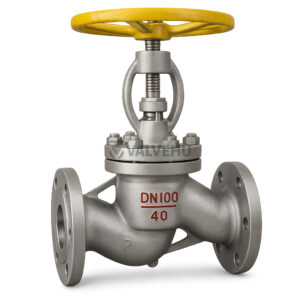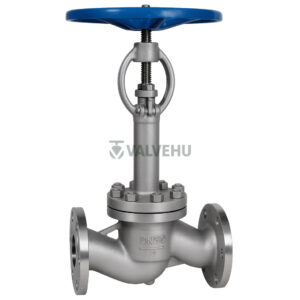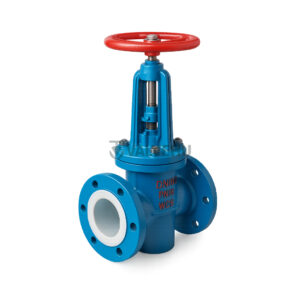-
Industrial Globe Valve PN1.6/2.5 Cast Steel Flanged Handwheel Type
Industrial globe valve with cast steel body, flanged connection, PTFE packing, and Stellite sealing surface. PN1.6/2.5 pressure rated, suitable for ammonia, water, steam, and oil applications.
-
J11W Globe Valve PN1.6 to 16MPa SS Body BSP/NPT Internal Thread
Stainless steel threaded globe valve by VALVEHU, pressure-rated up to PN16.0 MPa, with rising stem and handwheel, suitable for water, oil, gas, and select corrosive media applications.
-
Low Temperature Globe Valve PN16 Stainless Steel Flanged Manual Operated
Low Temperature Globe Valve with stainless steel body, PN16 pressure class, flanged connection, and cryogenic performance down to –196°C. Fully compliant with GB/T standards for structural and sealing integrity.
-
PTFE Lined Globe Valve J41/J45 Flanged Cast Steel Manual
Buy Flanged Gate Valve J41F-J45F PN1.0/1.6MPa WCB/PTFE Lined Handwheel Type The J41F/J45F Flanged Gate Valve by VALVEHU is an industrial-grade valve engineered for reliable shut-off control in corrosive media pipelines and chemical processing environments. Designed to meet standards such as GB/T 12233, GB/T 12235, and HG/T 20592, this valve ensures long-term performance and structural integrity […]
-
Threaded Globe Valve J11W-16P PN1.6–4.0 Stainless Steel Manual Type
Stainless steel internal threaded stop valve for industrial use, rated PN1.6–16.0MPa, corrosion-resistant, temperature tolerant up to 180°C, compatible with water, oil, air, and mild acids.
What Is a Globe Valve and Why Is It Used?
A globe valve is a type of linear motion valve designed to regulate flow in pipelines. Named after its typically globe-shaped body, this valve allows precise throttling, making it ideal for systems where flow control and shut-off are both required. Commonly used in oil and gas, chemical plants, and power generation, globe valves offer better sealing performance than gate valves. Choosing a reliable globe valve manufacturer is crucial to ensuring long-term performance, especially under high-pressure or corrosive conditions.
How Does a Globe Valve Work? Understanding the Mechanism
The working principle of a globe valve revolves around a movable plug (disc) and a stationary seat within the valve body. The plug is connected to a stem that is actuated manually or automatically, moving perpendicular to the flow. This design allows fine control over fluid flow, minimizing leakage and ensuring consistent performance. Whether you purchase from a globe valve seller or a valve supplier, understanding the internal mechanism helps in selecting the right model for your application.
Top Applications of Globe Valves in Industrial Systems
Globe valves are used in a variety of industries due to their precise flow control and durability. Key applications include:
- Steam lines requiring bellow seal globe valves
- High-temperature oil systems
- Water treatment and filtration units
- Cryogenic applications involving cryogenic globe valves
- HVAC and building automation systems When working with a globe valve factory, you can often request custom configurations to match specific project needs.
Can a Globe Valve Be Installed Vertically? Installation Guide
Yes, a globe valve can be installed vertically, provided the design supports upward flow and does not trap debris. Vertical installations are common in limited-space environments, especially with angle globe valve configurations. Always consult your valve supplier or refer to technical datasheets from your globe valve manufacturer to ensure compatibility with vertical mounting.
How to Identify the Difference Between Gate Valve and Globe Valve
Distinguishing between a gate valve and a globe valve is essential for proper system design. While gate valves are primarily used for full shut-off with minimal flow resistance, globe valves are designed for both shut-off and throttling. Key differences include:
- Flow path: linear in gate valves, Z-pattern in globe valves
- Function: on/off vs. regulation
- Size and weight: globe valves are generally heavier due to the internal structure Discuss your application with a trusted globe valve supplier to make the right selection.
Types of Globe Valves Explained: Which One Fits Your System?
There are multiple globe valve types available to suit various applications:
- Angle globe valve: Reduces piping and fittings in 90° turns
- Y-pattern globe valve: Lower pressure drop, ideal for continuous flow
- Bellow seal globe valve: Prevents leakage in toxic or high-purity systems
- Cryogenic globe valve: Designed for ultra-low temperature applications Choosing the correct type is critical. Leading globe valve manufacturers offer technical consultations to help you select the most efficient solution.
How to Order the Right Globe Valve at the Best Price
Finding the right globe valve at a competitive price requires more than just comparing numbers. Start by identifying your system’s technical requirements-such as valve size, pressure rating, material, and actuation type. Then, evaluate potential suppliers based on both quality and service.
Working directly with a certified globe valve manufacturer or trusted valve supplier helps ensure product authenticity, proper documentation, and technical support. Don’t forget to consider factors like warranty, lead time, and post-sales service when comparing offers.
If you’re seeking a reliable partner, VALVEHU stands out as a professional globe valve manufacturer with deep expertise and factory-direct solutions. We produce a full range of globe valve types-including angle, cryogenic, bellow seal, and more-tailored for diverse industrial needs. As a global valve supplier, VALVEHU combines competitive pricing with strict quality control and responsive service.
Whether you’re sourcing for OEM use, project-based installations, or long-term supply contracts, VALVEHU offers the performance and peace of mind professionals expect.






